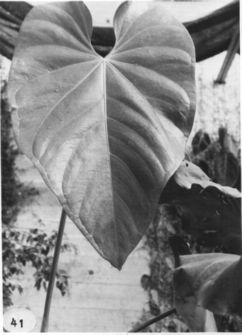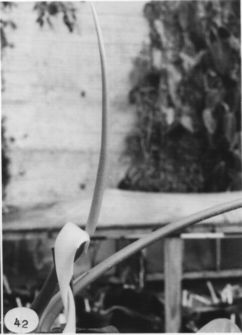





Anthurium colonense Croat, sp. nov.
TYPE: Panama. Colón: Río Guanche above bridge on Portobelo Road, ca. 3-5 km above bridge, 50-200 m, Croat 36959 (MO 2395448-50, holotype; B, F, K, NY, PMA, SEL, US, VEN, isotypes; Live at MO).
Epiphyte; stems to 20 cm long, ca. 5 cm diam.; leaf scars 4-4.5 cm wide; roots thick, green, more or less smooth, descending; cataphylls coriaceous 21-27 cm long, acute at apex (the acumen apiculate), sometimes splitting at base while still fresh, drying brown (B & K Yellow 3/7.5), the apex persisting intact, splitting at base, ultimately deciduous.
LEAVES erect to spreading; petioles 32-98 cm long, 1-1.5 cm diam., subterete, sometimes weakly flattened to narrowly and shallowly sulcate; geniculum 3-5 cm long; blades ovate, moderately thick, abruptly acuminate at apex, deeply lobed at base, 31-99 cm long, 21-74 cm wide, broadest at middle or just below; anterior lobe 27-56 cm long, the margins rounded; posterior lobes 9-20 cm long from apex of sinus to outermost point; sinus hippocrepiform to spathulate, acute to rounded at apex; both surfaces semiglossy; midrib acutely raised above and below, yellowish below; basal veins 6-9 pairs, first, second and sometimes third free to base, those remaining coalesced 3.5-4.5 cm, raised above and below, posterior ribs turned up, naked; primary lateral veins 3-7 per side, departing midrib at 45-50° angle, raised at midrib, sunken near collective vein above, raised below; interprimary veins flat to weakly sunken above, raised below, secondary veins flat above and below; collective vein arising from one of the primary lateral veins in the upper half of the blade, 1-1.3 cm from the margin, flat to weakly sunken above, prominulous below.
INFLORESCENCE erect to spreading, shorter than leaves; peduncle 18-38 cm long, 0.6-1 cm diam., subterete; spathe subcoriaceous, pale green (B & K Yellow-green 8/10), lanceolate to oblong-lanceolate, 20-37 cm long, 4ų6 cm wide, broadest just above base, long-acuminate at apex, acute at base, inserted at 45° angle on peduncle; spadix yellow-green (B & K Yellow-green 8/7.5), 28.3-48 cm long, 1.3-2 cm diam. near base, 5-7 mm diam. near apex; flowers rhombic to 4-lobed, 2.7-3.7 mm long, 2.5-3 mm wide, the sides straight to sigmoid, 8-12 flowers visible in the principal spiral, 6-8 flowers visible in the alternate spiral; tepals glossy, minutely and densely papillate, lateral tepals 1-2.2 mm wide, the inner margin convex; pistils weakly raised, green; stigma linear; stamens not emerging, pollen oozing out in long, flat ribbons, beginning at the base, pollen yellowish fading to white.
INFRUCTESCENCE pendent; berries orange (B & K Yellow-red 8/7.5), narrowly obovoid, acute at apex, 1.5-1.6 mm long, 4.3 mm diam. at base, 1.4 mm diam. at apex; mesocarp orange, gelatinous; seeds 2, green tinged brownish at base and apex, ovoid, ca. 0.5 mm long, 0.2 mm wide, both ends with a sticky, clear appendage. Figs. 41 and 42.
Anthurium colonense is endemic to Panama in the Provinces ofVeraguas, Code, Colón, Darien, and the Canal Zone from sea level to 1,500 m. It is found in tropical wet and lower montane wet forest life zones.
The species is probably the largest member of section Calomystrium occurring in Panama and is recognized by its moderately thick, ovate blades, its long tapered spadix that has no stamens emerging but oozes pollen in flat ribbons. It is also recognized on drying by its blackish color.
Anthurium colonense is similar to the larger plants of A. curvispadix but that species has a somewhat longer peduncle, a shorter spadix, and has not been known to dry blackish as does A. colonense.
 |
 |
Map of Mesoamerican specimens with coordinates
PanamaCoclé: 150 m, 8.46N 80.27W, 11 Sept. 1987, Thomas B. Croat 67485
(MO).
Panama Colón: < 100 m., 09.27N 79.40W, 19 June 1994, Thomas B. Croat
& Guanghua Zhu 76248 (MO).
Panama Colón: 50-200 m,, 8 July 1976, Thomas B. Croat 36959 (MO).
Panama Colón: 30-100 m, 09.30N 79.30W, 22 September 1996, Thomas B.
Croat 79338 (K, MO).
Panama Darien: 200 m, 8.01N 77.25W, 13 Oct 1987, B. Hammel G. de Nevers,
H. Cuadros, & H. Herrera 16171 (MO).
Map of South American Specimens with coordinates
Ecuador Napo: BLACK DRYING, E SLOPE, 350 m, 00.02S 76.42W, 29 Dec 1987
- 31 Dec 1987, Carlos E. Cerón M. & Miguel Cerón 3099
(MO). Ecuador Napo: Jatun Sacha, 400 m, 01.04S 77.36W, 18 May 1989, Walter
Palacios 4234 (MO, QCNE).
Ecuador Pastaza: BLACK DRYING, E SLOPE, 500 m, 01.29S 77.27W, 24 Jul
1992, Walter Palacios 10287 (MO, QCNE).
.